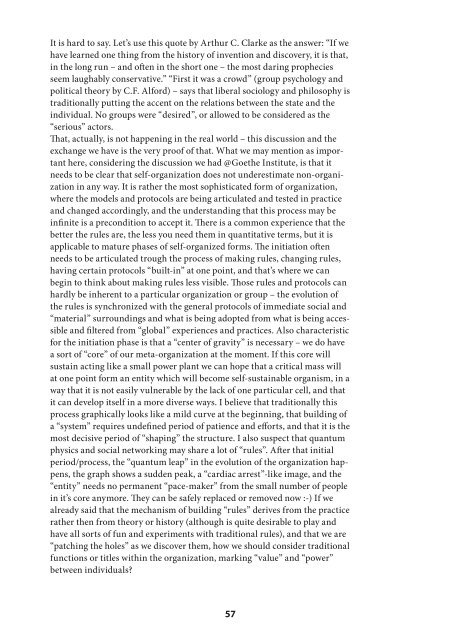You also want an ePaper? Increase the reach of your titles
YUMPU automatically turns print PDFs into web optimized ePapers that Google loves.
It is hard to say. Let’s use this quote by Arthur C. Clarke as the answer: “If we<br />
have learned one thing from the history of invention and discovery, it is that,<br />
in the long run – and often in the short one – the most daring prophecies<br />
seem laughably conservative.” “First it was a crowd” (group psychology and<br />
political theory by C.F. Alford) – says that liberal sociology and philosophy is<br />
traditionally putting the accent on the relations between the state and the<br />
individual. No groups were “desired”, or allowed to be considered as the<br />
“serious” actors.<br />
That, actually, is not happening in the real world – this discussion and the<br />
exchange we have is the very proof of that. What we may mention as important<br />
here, considering the discussion we had @Goethe Institute, is that it<br />
needs to be clear that self-organization does not underestimate non-organization<br />
in any way. It is rather the most sophisticated form of organization,<br />
where the models and protocols are being articulated and tested in practice<br />
and changed accordingly, and the understanding that this process may be<br />
infinite is a precondition to accept it. There is a common experience that the<br />
better the rules are, the less you need them in quantitative terms, but it is<br />
applicable to mature phases of self-organized forms. The initiation often<br />
needs to be articulated trough the process of making rules, changing rules,<br />
having certain protocols “built-in” at one point, and that’s where we can<br />
begin to think about making rules less visible. Those rules and protocols can<br />
hardly be inherent to a particular organization or group – the evolution of<br />
the rules is synchronized with the general protocols of immediate social and<br />
“material” surroundings and what is being adopted from what is being accessible<br />
and filtered from “global” experiences and practices. Also characteristic<br />
for the initiation phase is that a “center of gravity” is necessary – we do have<br />
a sort of “core” of our meta-organization at the moment. If this core will<br />
sustain acting like a small power plant we can hope that a critical mass will<br />
at one point form an entity which will become self-sustainable organism, in a<br />
way that it is not easily vulnerable by the lack of one particular cell, and that<br />
it can develop itself in a more diverse ways. I believe that traditionally this<br />
process graphically looks like a mild curve at the beginning, that building of<br />
a “system” requires undefined period of patience and efforts, and that it is the<br />
most decisive period of “shaping” the structure. I also suspect that quantum<br />
physics and social networking may share a lot of “rules”. After that initial<br />
period/process, the “quantum leap” in the evolution of the organization happens,<br />
the graph shows a sudden peak, a “cardiac arrest”-like image, and the<br />
“entity” needs no permanent “pace-maker” from the small number of people<br />
in it’s core anymore. They can be safely replaced or removed now :-) If we<br />
already said that the mechanism of building “rules” derives from the practice<br />
rather then from theory or history (although is quite desirable to play and<br />
have all sorts of fun and experiments with traditional rules), and that we are<br />
“patching the holes” as we discover them, how we should consider traditional<br />
functions or titles within the organization, marking “value” and “power”<br />
between individuals?<br />
57


